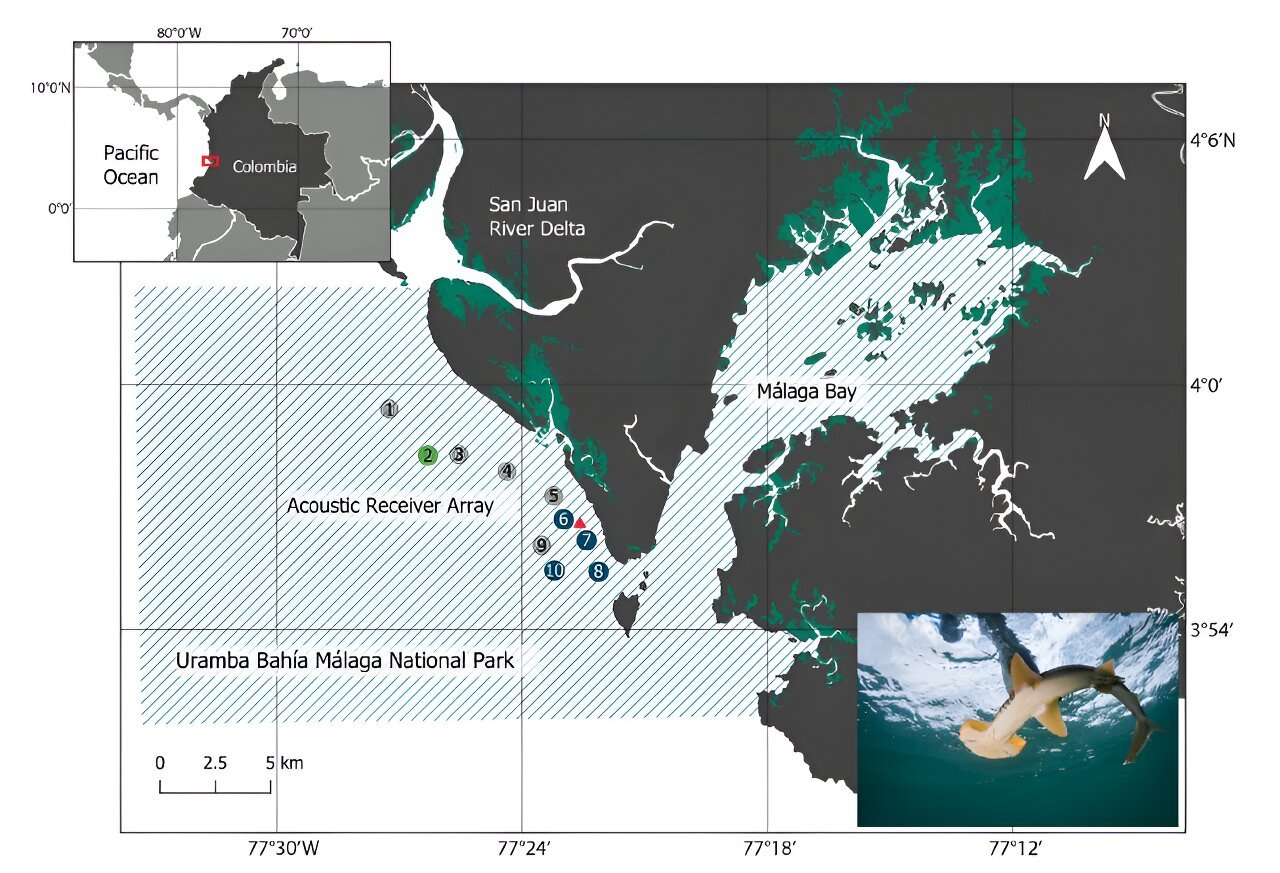
Researchers are advocating for a “no-take zone” off the coast of Colombia after one of the world’s smallest and most threatened hammerhead species was found to do very little traveling outside of a Marine Protected Area in the region.
A team of researchers including FIU shark biologists Diego Cardeñosa and Yannis Papastamatiou, tracked the movements of scalloped bonnetheads inside a marine protected area (MPA) along the Colombian Pacific Coast, where this species still occurs in high numbers. Using acoustic telemetry, a technique that tracks underwater movements through sound signals, they determined the sharks spent a significant portion of their monitoring period within the study area.
The research is published in the journal Marine Ecology Progress Series.
“Using telemetry, we show these little sharks are very residential to small areas,” Papastamatiou said. “This is bad news if overfishing occurs but good news for designing well placed, and enforced, protected areas.”
Research typically focuses on the large, iconic hammerheads, but very little research exists on the scalloped bonnethead—the smallest of the nine recognized hammerhead species—which is classified as critically endangered by the IUCN Red List. This new study provides the first insights into the movement behavior of the scalloped bonnethead with important implications for its protection and management.
“This study is the first of its kind for this species, the most threatened hammerhead shark in the world endemic to the eastern pacific,” said Cardeñosa, corresponding author in the study. “The results show us that localized conservation efforts with local fishing communities is the most effective strategy to protect this species.”
The Colombian Pacific coast is heavily fished by small-scale fisheries. About 7% of the coast is protected, with only three national parks in the region. The study was carried out in the Uramba Bahía Málaga National Natural Park, an area encompassing 181 square miles.
Established in 2010, it is a biodiversity hotspot featuring the highest above-ground mangrove forest biomass of any region outside the Coral Triangle—a vital marine region spanning six countries.
For this study, the researchers looked at the sharks’ movement patterns to assess how long they stay in the area, the influence of tides and time of day on their movements, and the degree of protection a no-take zone could provide in this location.
According to the acoustic data, their movements were limited to just 0.54 square miles within the park. Data also showed the scalloped bonnetheads spent less time in the area at high tide and at night, suggesting more movement and more activity at those times.
According to the study, this combination of small space use and high residency makes the scalloped bonnethead especially vulnerable, but it also makes a strong case for creating an MPA surrounding that core area. Establishing a small no-take zone within the National Park’s MPA—less than 2 miles along the coastline and extending about 1.25 miles offshore—would cover a significant part of the area used by this small coastal shark and could have great benefits for conservation.
The findings have been shared with the local communities and, in a joint effort, the goal is to establish a no-take zone that prohibits the capture or removal of the sharks. The no-take zone would also safeguard the needs of the community and would be under the management of local stakeholders. The researchers note that shark movement data should be incorporated with the interests of all local stakeholders for an optimal MPA to be effective.
The study was a collaboration between the FIU Global Forensic and Justice Center, the Guy Harvey Research Institute and the Save our Seas Foundation Shark Research Center at Nova Southeastern University and the Centro de Investigaciones Oceanográficas e Hidrográficas del Pacífico in Colombia.
More information:
MA Herrera et al, High residency of a Critically Endangered hammerhead shark to a small area: implications for marine protected area management and design, Marine Ecology Progress Series (2024). DOI: 10.3354/meps14658
Provided by
Florida International University
Citation:
Small ‘no-take zone’ can help protect critically endangered hammerhead shark in Columbia (2024, September 20)
retrieved 20 September 2024
from https://phys.org/news/2024-09-small-zone-critically-endangered-hammerhead.html
This document is subject to copyright. Apart from any fair dealing for the purpose of private study or research, no
part may be reproduced without the written permission. The content is provided for information purposes only.
